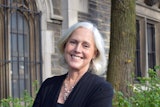A new brief from the Center for Law and Social Policy (CLASP) finds that nearly three in four students experience unmet need, making this problem around college affordability a nearly “universal phenomenon” among today’s students.
 Lauren Walizer
Lauren WalizerOffering an overview of students’ average unmet need by race, income status and institution type from academic year 2015-16, the brief “When Financial Aid Falls Short” provides several recommendations for policymakers to address unmet need, including investing in public institutions and need-based aid programs, improving calculations in the Free Application for Federal Student Aid (FAFSA) process and modernizing financial aid and economic security policies, among others.
Unmet need is “a problem for most students … but it also really matters who you are,” said Lauren Walizer, author of the brief and a senior policy analyst with CLASP’s Center for Postsecondary and Economic Success.
For instance, Walizer pointed out that Asian American students consistently have the highest dollar amount of need, while Black students are the most likely to have unmet need.
Additional brief findings included:
· The average unmet need for community college students significantly increased 23 percent between 2011-12 ($4,011) and 2015-16 ($4,920).
· Across the board, Asian American students have the greatest amount of unmet need, regardless of the institution they attend;
· Black students in the lower-middle quartile have more unmet need than their bottom quartile peers at public two year colleges; similarly, Latinx students in the lower-middle quartile have more unmet need than their bottom quartile peers at public four-year institutions.
· Public community college students have the least amount of unmet need, but they still face significant financial challenges. Those in the lowest-income quartile have more than $6,900 in unmet need, and those in the lower-middle quartile have an average of $6,315 in unmet need;
· Students attending public four-year colleges have an average unmet need of nearly $9,100;
· Private college students have an average unmet need of $14,000, while for-profit college students have an unmet need of nearly $15,000.
The brief calls attention to unmet need – the gap between the total cost of college and all student resources that do not have to be repaid, such as scholarships, grant aid and a student’s Expected Family Contribution (EFC) – as a “rough measure of our nation’s underinvestment in students that highlights the gap between expectations of affordability and reality.”
“While unmet need gives some indication of student financial burden, it is limited in some respects,” the brief added.
Unmet need only details the need gap for one year of college and not the aggregate of all four years of attendance. Further, research shows that between one-third and one-fifth of colleges produce cost of attendance estimates that are 20 percent or more below the actual local cost of living, the brief said, adding that this is more likely to occur at two-year and vocational schools, which largely serve low-income students and students of color.
Unmet need also subtracts a student’s EFC, assuming it was calculated correctly and the student can afford to pay the amount out of pocket.
This calculation of aid assumes that a student’s EFC is “in the bank and ready to go” when in reality, a low-income student or student who is contributing to other family expenses may not have these funds available, said Carrie Warick, director of policy and advocacy at the National College Access Network (NCAN).
 Carrie Warick
Carrie WarickNCAN works with nonprofits, institutional programs and more, and is an organization focused on helping underrepresented students gain access to and succeed in their postsecondary education.
“This [report] really quantifies the stories we’ve been hearing from our members” – that low-income students can do everything right on their FAFSA and still not have an affordable option for college, Warick said.
A NCAN white paper on college affordability published earlier this year similarly found that the average Pell Grant recipient in NCAN’s model would only be able to afford to attend just 139 of 551 residential four-year public institutions in the United States. Only 10 percent of flagship universities were deemed affordable for the average Pell recipient.
CLASP’s recommendations for policymakers emphasize a need for states to center equity and diversity in their higher education plans.
This includes increasing the value of Pell Grants and investing in more need-based aid programs, such as Federal Work-Study, Supplemental Educational Opportunity Grants and Title III aid for minority-serving institutions.
Policymakers can additionally work to improve the calculation of students’ EFC, improve how colleges estimate their true cost of attendance and consider capitalizing on existing wraparound resources that support eligible students like Medicaid, Supplemental Nutrition Assistance Program (SNAP) or childcare subsidies.
Prioritizing need-based aid first and targeting that aid to the students with the greatest financial need has also been a recommendation among college affordability advocates, in addition to restructuring free college programs as “first-dollar” instead of “last-dollar” models.
This year, Nashville mayor David Briley established the Nashville Getting Results by Advancing Degrees (GRAD) program as an extension of the Tennessee Promise program. The $1 million initiative, set for 2019-20, will provide scholarships for books, transportation, food and living expenses, non-academic expenses that have largely not been covered by free tuition programs.
Walizer said part of this work requires policymakers to understand who their state’s college-going students are today. They are individuals who are “multidimensional,” often working, and supporting their family, she said.
“There is an assumption among some policymakers that students who are going to community college right after high school” continue to live with their parents, Warick added. “That’s just not the reality we find with a lot of low-income students.”
Tiffany Pennamon can be reached at tpennamon@diverseeducation.com. You can follow her on Twitter @tiffanypennamon.
















